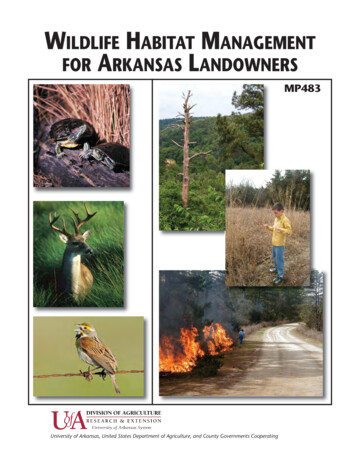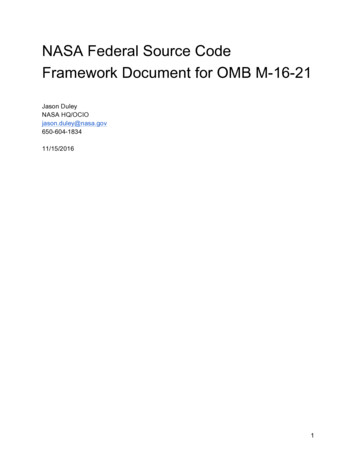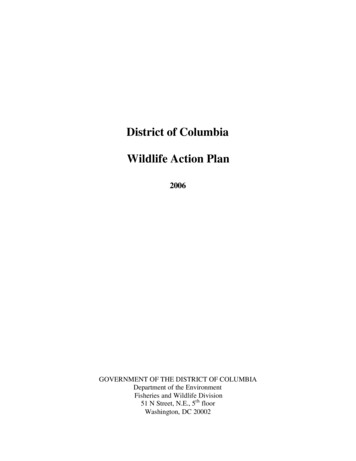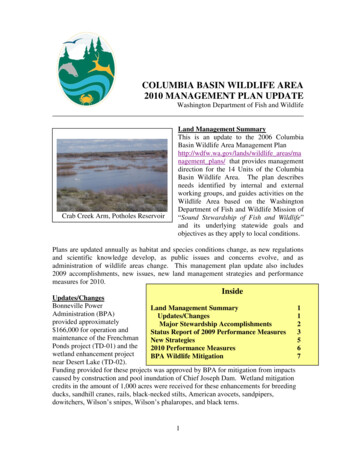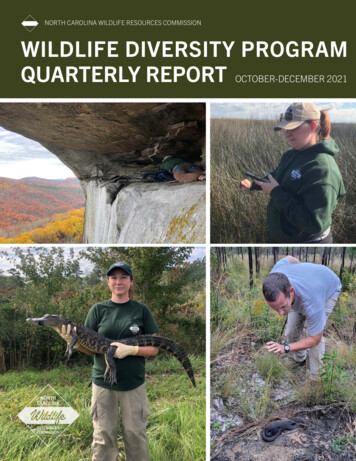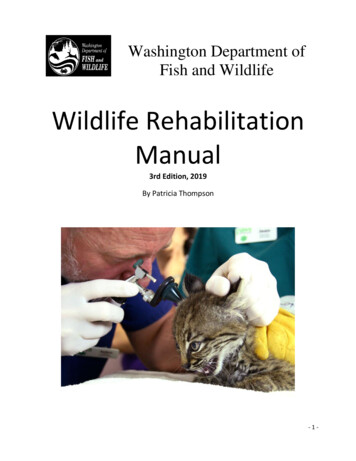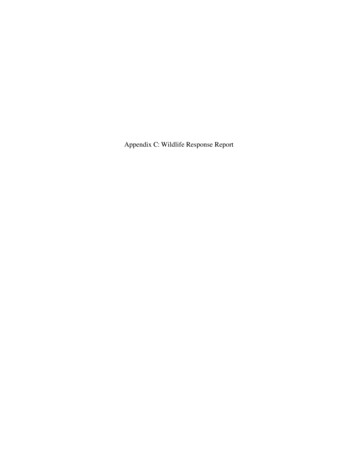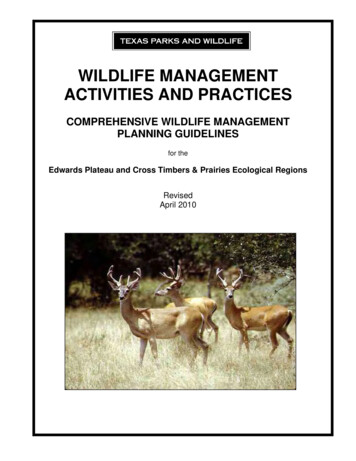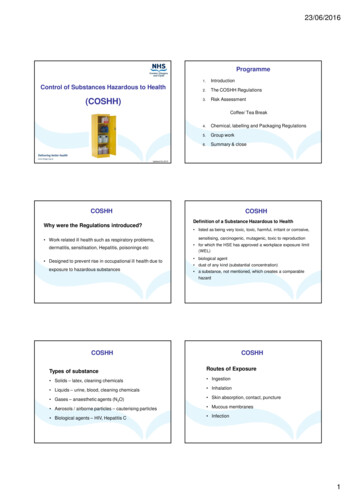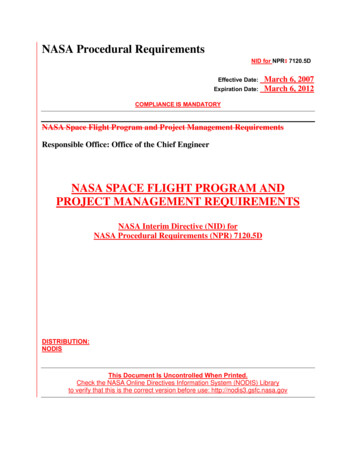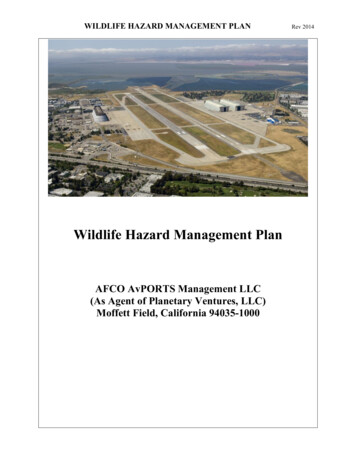
Transcription
WILDLIFE HAZARD MANAGEMENT PLANWildlife Hazard Management PlanAFCO AvPORTS Management LLC(As Agent of Planetary Ventures, LLC)Moffett Field, California 94035-1000Rev 2014
WILDLIFE HAZARD MANAGEMENT PLANRev 2014MOFFETT FEDERAL AIRFIELDNASA AMES RESEARCH CENTER, CASubmittedAirport Director, AvPORTSiDate:
WILDLIFE HAZARD MANAGEMENT PLANAcronyms and AbbreviationsACAdvisory CircularAFBAir Force BaseAFSC/SEFWAir Force Safety Center/Safety Flight WildlifeAOAvPORTS Airport OperatorAOAAirport Operations AreaAPDAmes Policy DirectiveAPRAmes Procedural RequirementsATCAir Traffic ControlATISAutomated Terminal Information ServiceBASHCA ANG Bird/Wildlife Aircraft Strike HazardBRACBase Realignment and ClosureBWHCBird/Wildlife Hazard ConditionsCA ANGCalifornia Air National GuardCDFWCalifornia Department of Fish and WildlifeCDCCenters for Disease Control and ProtectionCFRCode of Federal RegulationsDODDepartment of DefenseDOIDepartment of the InteriorEAEnvironmental AssessmentEISEnvironmental Impact StatementEMDNASA Environmental Management DivisionEOExecutive OrderEPAEnvironmental Protection AgencyESAEndangered Species ActFAAFederal Aviation AdministrationFPEISFinal Programmatic EISFODForeign Object DebrisHHSDepartment of Health and Human ServicesIAPInternational American ProductsIPMIntegrated Pest ManagementKNUQICAO Identifier for Moffett Federal AirfieldiiRev 2014
WILDLIFE HAZARD MANAGEMENT PLANKNUQ/MFAMoffett Federal Airfield at NASA Ames Research CenterKSJCMineta San Jose International AirportKSFOSan Francisco International AirportMFAMoffett Federal Airfield at NASA Ames Research CenterMIMPMitigation Implementation and Monitoring PlanMOAMemorandum of AgreementMOUMemorandum of UnderstandingNADPNASA Ames Development PlanNASNaval Air StationNASANational Aeronautics and Space AdministrationNEPANational Environmental Policy ActNOTAMNotice to AirmenNWHCNational Wildlife Health CenterRODRecord of DecisionRWOCBRegional Water Quality Control BoardUSAFUnited States Air ForceUSDAUnited States Department of AgricultureUSEPAUnited States Environmental Protection AgencyUSFWSUnited States Fish and Wildlife ServiceUSGSUnited States Geological SurveyWHMPWildlife Hazard Management Plan for PV Property at MFAWSWildlife ServicesiiiRev 2014
WILDLIFE HAZARD MANAGEMENT PLANRev 2014Historical Record of Revisions to Precedent PlanChange NumberEntered ByDate Entered10/05RW, Code Q, & TJ10/26/20057/07USDA, Code JO7/6/20077/07-1Code JO7/12/20078/07Code JO8/21/20078/07-1Code JO8/28/20073/08Code QE &JO3/25/20084/08Code JO4/1/20084/08-1Code JO4/7/200810/08Code JO & 14AvPORTS Airport Director 10/01/2014This plan, the new “Wildlife Hazard Management Plan” is being established by AFCOAvPORTS Management LLC (As Agent of Planetary Ventures, LLC) for Moffett Field,California 94035-1000 by the ground lessee of Moffet Field and shall be effective upon the dateof such transfer. The plan adopts and incorporates elements of the wildlife hazard managementplan in place at the time of the leasehold interest transfer of the property to the ground lessee,including revisions listed above.iv
WILDLIFE HAZARD MANAGEMENT PLANRev 2014Table of ContentsPage1.WILDLIFE HAZARD ASSESSMENT112.FAA APPROVAL353.AUTHORITY35Program Authority35Grounds Maintenance36Active Harassment36Depredation Control36Reporting374.INSPECTION OF MOVEMENT AREASSweeps of Runways37374.1.1 Early Morning374.1.2 Opening a Runway374.1.3 Upon Demand374.1.4 Dead, Sick and Injured Wildlife37Bird/Wildlife Hazard Condition (BWHC) Determinations4.1.5 Bird/Wildlife Hazard Conditions:3838Bird Strike Reports394.1.6 Report Form394.1.7 Species Identification395.WILDLIFE CONTROL MEASURES39Vegetation40Pyrotechnics405.1.1 Pyrotechnics Safety (also see AO Wildlife Control Safety Plan-Appendix 6)415.1.2 Operation415.1.3 Potential Problems41Bioacoustics425.1.4 Operation425.1.5 Potential Problems42Propane Cannons425.1.6 Operation425.1.7 Safety (Also see AO Wildlife Control Safety Plan-Appendix 6)425
WILDLIFE HAZARD MANAGEMENT PLAN5.1.8 Potential ProblemsRev 201443Traps435.1.9 Operation43Food Source ion445.1.11Potential Problems45Firearms45Other Wildlife Control Methods456.45COMMUNICATIONSHarassment Operations45ATC45ATIS46NOTAM467.REVIEW OF THE WILDLIFE MANAGEMENT PROGRAM46Aviation Safety Committee46Summary Report46Bird Hazard Working Group (BHWG)47Airfield Wildlife Control Safety Plan58Map 1Moffett Federal Airfield at NASA Ames10Map 2PV Property11Figure 1Avian Population Trends Of Guilds Observed By Calendar Year15Figure 2Waterfowl Population Trends16Figure 3Starlings/Blackbirds Population Trends16Figure 4Songbirds Population Trends17Figure 5Shorebirds Population Trends17Figure 6Regional Area24Table 1Nationwide Civilian Bird Strikes12Table 2Hazard Rankings of Birds Commonly Invloved In Damaging Strikes14Table 3Bird Aircraft Strike Data18Table 4Reported Phase of Flight at Time of Occurrence of Wildlife Strikes256
WILDLIFE HAZARD MANAGEMENT PLANRev 2014PREFACEThe purpose of this Wildlife Hazard Management Plan (WHMP) is to establish guidelines tominimize aircraft exposure to potentially hazardous wildlife while assuring compliance withwildlife conservation laws, regulations, Federal Executive Orders (EO), and Planetary Ventures,LLC (PV) policies and procedural requirements, and any applicable National Aeronautics andSpace Administration (NASA) Ames Research Center policies and procedural requirements.This plan is not intended to cover every contingency that may arise or every rule of safety andgood operating practice. The rules, procedures, and guidelines in this plan are to be consideredas minimum standards. This plan should be used in conjunction with other governing directives,regulations, and procedures. This plan supersedes prior editions.This plan is prepared in accordance with the guidelines established by the Federal AviationAdministration (FAA) for commercial air carrier airports under the provisions of Title 14 Codeof Federal Regulations (CFR) Part 139.337.When the need arises, special instructions or waivers will be issued by the AO and any otheraffected directorate or agency concerned. Special instructions will be supplemental to this planand will be considered as standard operating procedures. In due course, special instructions willeither be incorporated into this WHMP or canceled. Deviations or waivers from this WHMP areauthorized in emergencies or in situations where flight or ground safety might otherwise becompromised. Written documentation of deviations is required and must be transmitted to theAO no later than 10 calendar days following any deviation from these guidelines.This WHMP may be revised by new editions or updated by page changes or pen-and-inkcorrections. When corrections or page changes are entered, the changes shall be annotated onthe Record of Revisions page.Comments and recommendations concerning this WHMP are encouraged and should besubmitted to the AO. Extra copies of this WHMP can are obtained from the AO.7
WILDLIFE HAZARD MANAGEMENT PLANRev 2014INTRODUCTIONMoffett Federal Airfield at NASA Ames (KNUQ/MFA)is a restricted use Federal airfield ownedby the National Aeronautics and Space Administration (NASA) that is leased to PV as of[October 1, 2014] (PV Property) (Map 2), and operated by AFCO AvPORTS Management LLC(AvPORTS) as PV’s agent its Airport Director, Airport Operator (AO) to meet the needs of PV,NASA, the California Air National Guard (CA ANG), other Resident Agencies, and other NASAAmes Research Center (NASA Ames) authorized users. The Navy, and at various times othermilitary services, managed the airfield as a military airfield from the 1930s when Congressestablished the Naval Air Station (NAS) at Moffett Field in 1933 until 1994 when the Navytransferred ownership to NASA following a 1992 Base Realignment and Closure Act (BRAC)decision.The FAA and the United States Air Force (USAF) have documented wildlife aircraft strike datanationally in the FAA National Wildlife Strike Database and the USAF wildlife strike database.The airfield and the California Air National Guard (CA ANG) have compiled data for wildlifestrikes at KNUQ/MFA. Prior to the 1994 BRAC transfer, the Navy had compiled bird-strike datafor KNUQ/MFA at NASA Ames.Because the CA ANG is one of the primary tenants on the airfield and has developed aBird/Wildlife Aircraft Strike Hazard (BASH) Plan similar to the NASA Ames Wildlife HazardManagement Plan, the AO reviewed both FAA guidance and USAF and Department of Defense(DOD) guidance. The USAF and DOD, of which the Air National Guard Bureau and CA ANGare entities therein, have signed several agreement documents with the U.S. Fish and WildlifeService (USFWS) and other agencies regarding wildlife and wetlands conservation and hazardmanagement. These include: the 2003 “Memorandum of Agreement (MOA) Between theFederal Aviation Administration, the U.S. Air Force, the U.S. Army, the U.S. EnvironmentalProtection Agency, the U.S. Fish and Wildlife Service, and the U.S. Department of Agricultureto Address Aircraft-Wildlife Strikes” and the 2006 “Memorandum of Understanding (MOU)Between the U.S. Department of Defense and the U.S. Fish and Wildlife Service to Promote theConservation of Migratory Birds.” The 2003 MOA incorporates the FAA Advisory Circular(AC) 150/5200-33, Hazardous Wildlife Attractants on or Near Airports, which was updatedAugust 28, 2007. The USAF has since revised its guidance as USAF Pamphlet 91-212,Bird/Wildlife Aircraft Strike Hazard (BASH) Management Techniques (Feb. 1, 2004).Historically, the NASA Ames Airport Management Office, in consultation with the NASA AmesEnvironmental Management Division (EMD), and upon review of wildlife strike data forairfields nationwide and at KNUQ/MFA and FAA and USAF guidance documents for managingwildlife risk to aircraft, have established that a potential for moderate to severe wildlife hazardexists at KNUQ/MFA.The primary risks at KNUQ/MFA are associated with the airfields historic location in a grassyupland ecosystem adjacent to wetlands in the Pacific Flyway and with human activity at and inthe vicinity of the airfield which attracts mammals, large bodied birds, and flocking birds posingsevere to moderate risk of damage to aircraft and adverse effects on flight (Map 1).In light of these risks, the NASA Ames Airport Management Office and EMD implemented avariety of measures to reduce wildlife risk to aircraft at the airfield since the Navy transferred theairfield to NASA in 1994. Examples include habitat management and an active harassmentprogram. Prior to the Navy’s transfer, the Navy leased the unpaved areas of the airfield to a8
WILDLIFE HAZARD MANAGEMENT PLANRev 2014farmer who cultivated the land planting a variety of crops including, for example, oats, followingthe list of approved crops for use at airfields by the FAA to reduce wildlife hazards to aviation(AC 150/5300-13, Airport Design). Prior to establishment of the airfield by the Navy in the1930’s, the land was managed as part of a 500,000 acre ranch.PV and AvPORTS have adopted and, through the United States Department of Agriculture(USDA) Wildlife Services, are actively implementing appropriate measures in the PV Propertyand related areas to the PV Property. The PV Property includes the Golf Course at Moffett Fieldand portions of the Sunnyvale Municipal Golf Course that are managed by OB Sports (the “PVGolf Courses”). The purpose of this WHMP, therefore, is to establish recommended measures asguidelines to minimize aircraft exposure to potentially hazardous wildlife while assuringcompliance with wildlife and wetland conservation laws, regulations, Federal Executive Orders(EO), PV policies and procedures, and any applicable NASA Ames policy directives (APD) andprocedural requirements (APR).9
WILDLIFE HAZARD MANAGEMENT PLANMap 1. Moffett Federal Airfield at NASA Ames10Rev 2014
WILDLIFE HAZARD MANAGEMENT PLANRev 2014Map 2. PV Property1.WILDLIFE HAZARD ASSESSMENTThe FAA National Wildlife Strike Database provides information on the 119,917 reportedwildlife strikes at airfields in the United States during the period 1990 through 2011 (FAA 2012).Data for strikes that caused damage to one or more aircraft or had an adverse effect on anaircraft’s flight can be seen in Table 1. Using these data, FAA created a hazard ranking fordifferent types of wildlife based on degree of damage to aircraft and effect on flight (see Table 2)11
WILDLIFE HAZARD MANAGEMENT PLANRev 2014(FAA AC 150/5200-33B, Hazardous Wildlife Attractants On or Near Airports, dated Aug. 28,2007).On a scale of 1 (lowest risk) to 100 (greatest risk), large mammals, such as deer (100), and largebodied birds, such as vultures (64), geese (55), eagles (41) and ducks (39) present the mostsevere risk to aircraft. Owls, which vary greatly by species from pygmy to great horned owls,were rated at 23 as a group. Flocking birds, such as gulls (24), pigeons (23), and doves (14) andgrassy passerines, such as horned larks (17), meadowlarks (7), and swallows (4), present amoderate to severe risk. Crows and ravens were rated (16), kestrels rated a (9) and shorebirdsrated a (10). In 2003, the FAA, USAF, U.S. Army, U.S. Environmental Protection Agency(USEPA), USDA, and USFWS signed the Memorandum of Agreement (MOA) referencedearlier to address aircraft-wildlife strikes based on these data.1Table 1compiled from the FAA publication: Wildlife Strikes to Civil Aircraft in the UnitedStates 1990-2011, where identified wildlife groups or species that were involved in two or morestrikes, which caused damage to one or more aircraft components. The data is for 1990-2011and involves only civilian, U.S. aircraft.Table 1.Nationwide civilian bird strikesBirdsNo. reported s6Total waterfowl1,679Mallards(151)Canada geese(677)Total hawks, eagles, vultures1,0561The MOA between the FAA, USAF, U.S. Army, USEPA, USFWS, and USDA to Address Aircraft-WildlifeStrikes (2003) adopted the following definition of an aircraft-wildlife strike as when 1) a pilot reports than anaircraft struck 1 or more birds or other wildlife; 2) aircraft maintenance personnel identify aircraft damage as havingbeen caused by an aircraft-wildlife strike; 3) personnel on the ground report seeing an aircraft strike 1 or more birdsor other wildlife; 4) bird or other wildlife remains, whether in whole or in part, are found within 250 feet of arunway centerline, unless another reason for the animal’s death is identified; or 5) the animal’s presence on theairport had a significant, negative effect on a flight (i.e., aborted takeoff, aborted landing, high-speed emergencystop, aircraft left pavement area to avoid collision with animal) (Wildlife Control Procedures Manual, TechnicalPublication 11500E, 1994).12
WILDLIFE HAZARD MANAGEMENT PLANRed-tailedTurkey VulturesBald eagleFalcons/caracarasGallinaceous birds gersFinchesSparrowsTowheesHouse sparrowTotal known 51085621150122010210852135,566MammalsFlying mammals (bats)MicrobatsMegabatsTerrestrial mammalsMarsupials (Vir. Opossum)XenarthyrasLagomorphsRodents61117213Rev 2014
WILDLIFE HAZARD MANAGEMENT l known mammals967Rev 2014Table 2. Ranking of 25 species groups as to relative hazard to aircraft (1 most hazardous) based onthree criteria (damage, major damage, and effect-on-flight), a composite ranking based on all threerankings, and a relative hazard score. Data were derived from the FAA National Wildlife StrikeDatabase, January 1990–April 2003.2Ranking by ants9711933Herons111491027Hawks (buteos)1012121125Gulls1211131224Rock pigeon1310141323Owls1413201423H. lark/s. 1714Mourning ing2022192010American 234Sparrows252423244Nighthawks232525251Species group2Excerpted from the Special Report for the FAA, “Ranking the Hazard Level of Wildlife Species to Civil Aviationin the USA: Update #1, July 2, 2003”. Refer to this report for additional explanations of criteria and method ofranking.14
WILDLIFE HAZARD MANAGEMENT PLANRev 2014Many of the types of wildlife identified in the 2003 MOA and the FAA AC occur atKNUQ/MFA. USDA Wildlife Service has conducted yearlong assessments of wildlife hazardsat and near KNUQ/MFA. The results of that survey are on file at the AO. Figure 1 displays dataon observed wildlife at the airfield by calendar year. Species were broken into guilds of relatedbehavior and threats to aviation. Waterfowl numbers were at their greatest in 2010 followed bystarlings/blackbirds and songbirds. Waterfowl populations tended to increase during Novemberto December and spike from January through February (Figure 2). European starling/blackbirdspopulations increase in midsummer as juvenile population arrives and in fall as more birdsmigrate into the area (Figure 3). Shorebird populations increased in the late summer and fall(Figure 4). Other species were present in relatively small numbers throughout the year, as onespecies declines another increases to take its place (Figure 5).Figure 1. Avian Population Trends of guilds observed by calendar year, 2008-2011(USDA 2011)15
WILDLIFE HAZARD MANAGEMENT PLANRev 2014Figure 2. Waterfowl Population Trends observed by monthly calendar year, 2008-2011(USDA 2011)Figure 3. Starlings/Blackbirds Population Trends observed by monthly calendar year, 2008-2011(USDA 2011)16
WILDLIFE HAZARD MANAGEMENT PLANRev 2014Figure 4. Songbirds Population Trends observed by monthly calendar year, 2008-2011(USDA 2011)Figure 5. Shorebirds Population Trends observed by monthly calendar year, 2008-2011(USDA 2011)Table 3 depicts bird strikes at KNUQ/MFA as reported to the FAA and the USAF, Bird AircraftStrike Hazard (BASH) Team, AFSC/SEFW, Kirtland AFB for the period from June 2000through September 2012. Additional data from 1986 to 2004 are available in the Albion report(2004). Changing missions from Navy operations to NASA and resident agency operations atthe airfield in 1994 have impacted reporting procedures. From 1986 to 1994, when the Navyoperated the airfield, most bird aircraft strikes involved P-3’s. Since 1994, when the Navytransferred the airfield to NASA, strikes have involved mostly C-130’s. In most reports since1994, the wildlife species is identified.17
WILDLIFE HAZARD MANAGEMENT PLANRev 2014Table 3. Bird Aircraft Strike eNotesTAKEOFFCalifornia GullFUSELAGE / ANTENNA/ SKIN, PROPELLER,WING / ROTOR0GO-AROUNDCliff ,WINDSHIELD/CANOPY,WING/ROTORBarn SwallowUNKNOWNAmericanKestrelAIRCRAFT INVOLVEDIS NOT KNOWN. VMGR352 HAD TWO C-130SDEPART JUST PRIORTO THE BIRD BEINGFOUNDONTHERUNWAY.0TAKEOFFUNKNOWNWILDLIFE FOUND ONRUNWAY11530INITIAL CLIMBHorned LarkFUSELAGE / ANTENNA/ SKIN7501150TAKEOFFYellowrumpedWarblerRADOME / NOSEHC130N102511525INITIAL CLIMBCalifornia Gull14-Jun-01FXWG900UNKNOWNCalifornia GullWILDLIFE FOUND ONRUNWAY(AIRCRAFTSTRUCK BLOODRETRIEVEDFOR NOSE25-Jun-01FXWGUNKNOWNCliff SwallowWILDLIFE FOUND ONRUNWAY(AIRCRAFTSTRUCK UNKNOWN)11-Jul-01FXWG800UNKNOWNCliff SwallowWILDLIFE FOUND ONRUNWAY(AIRCRAFTSTRUCK 7-Oct-00MC130P04-Jun-0118ECM PODS / PYLONS,RADOME / NOSE
WILDLIFE HAZARD MANAGEMENT AltitudeAGLPhaseOperationofCommonNameRev PROPELLER0UNKNOWNCalifornia GullWILDLIFE FOUND ONRUNWAY(AIRCRAFTSTRUCK UNKNOWN)UNKWUNKNOWNAmericanKestrelWILDLIFE FOUND ONRUNWAY(AIRCRAFTSTRUCK C130P1630180UNKWENROUTEBarnSwallow/SwallowRADOME / NOSE28-May-03MC130P18151000GO-AROUNDCalifornia GullTAIL / INALRing-billedGullFUSELAGE / ANTENNA/SKIN,OTHER(SPECIFY IN hingBirdsFUEL TANKS, WING dHawkPROPELLERAIRCRAFT FROM SE,OTHER (SPECIFY igeonOUTSIDE ENGINE NO. 4RockDove/PigeonB-737 AIRCRAFT FROMVR-59 -- 20 INDIVIDUALBIRD STRIKES INSIDEENGINE NO. 1 AND ONLEFT WING.RockDove/PigeonFUELTANKS,FUSELAGE / ANTENNA/ SKIN, INSIDE ENGINENO. 2, INSIDE ENGINENO. 3, LANDING GEAR,LIGHTS,OUTSIDEENGINENO.2,OUTSIDE ENGINE NO.3,PROPELLER,RADOME / NOSE, TAIL /STABILIZER / RUDDER,WINDSHIELD/CANOPY, and WING KW0TAKEOFFLANDING19/
WILDLIFE HAZARD MANAGEMENT PLANCommonNameNotesUNKNOWNStriped SkunkFOUND DEAD ON 32RUNKNOWNBarn OwlTOWER REPORTED ANINJUREDBIRDONRUNWAY100TAKEOFFCalifornia GullFUEL TANKS140300APPROACHFINALWesternMeadowlarkFUEL TANKS, OUTSIDEENGINE NO. 2UNKWUNKWTAKEOFFWesternMeadowlarkCARCASS RECOVEREDFROM 32RUNKWUNKNOWNBurrowingOwlWILDLIFE FOUND ONRUNWAY(AIRCRAFTSTRUCK IAL 6-Feb-07UNKWUNKNOWNBarn owl03-Apr-07C-130UNKNOWNWestern haseOperationofRev 2014UNKWUNKNOWNCalifornia Gull22-MAY-07 UNKWUNKNOWNCalifornia Gull20STRIKESEVEREDWINGOFHAWK.RECOVEREDFROMRUNWAY BY CODE Q.WILDLIFE FOUND ONRUNWAY(AIRCRAFTSTRUCK UNKNOWN)BIRD FLUIDS FOUNDON NO. 4 PROPELLERNASAPERSONALFOUND CARCASS ONRUNWAYWILDLIFE FOUND VEREDFROM32RTWO WINGS FOUNDON32R AT CHARLIEWILDLIFE FOUND ON32R JUST NORTH OFALPHA(AIRCRAFTSTRUCK KNOWN)
WILDLIFE HAZARD MANAGEMENT onNameNotesUNKNOWNBarn owlWILDLIFE FOUND ON32R JUST NORTH OFALPHA(AIRCRAFTSTRUCK UNKNOWN)TOUCH & GOUNKNOWN09-Jul-07T-38C163217050TAKEOFFINITIAL CLIMBBarn UNKNOWN02-AUG-07 C-130UNKNOWNWestern Gull24-APR-08C-130UNKNOWNWhitethroated Swift29-APR-08C-130UNKNOWNCliff Swallow28-MAY-08 UNKWUNKNOWNGadwall12-AUG-08 UNKWUNKNOWNMexicanFree-tailedBat25-AUG-08 C-130UNKNOWNBlack-tailedJack Rabbit03-NOV-07 B-76706-MAR-08160921Rev 2014#2 ENGINE LOST NELANDING.SMALL BIRD IMPACTRIGHTSIDEOFFUSELAGE,BELOWCOPILOTS SEAT.WILDLIFE FOUND ON32R ON SOUTH END(AIRCRAFTSTRUCKUNKNOWN)WILDLIFE FOUND ON32RSOUTHOFCHARLIE(AIRCRAFTSTRUCK UNKNOWN)WILDLIFE FOUND ON32RAT3,500FTREMAININGSNARGTAKEN POST FLIGHTSMALLFLOCKOBSERVED BY PILOT.NO DAMAGE AND NOREMAINS RECOVERED.
WILDLIFE HAZARD MANAGEMENT -09 tailedBatUnknownPasserineMexicanFree-tailedBatRev 2014Notes18-NOV-09 OACHFINALWhitethroated SwiftOver SunnyvaleCourseUNKNOWNCliff SwallowFound dead on 32Rbetween markers 5/3UNKNOWNVesper BatFound blood on randomAPPROACHFINALUnknownPasserine100 Foot Final Moffett04-MAY-10 UNKW05-MAY-10 C-130220018-MAY-10 C-130Low level and patternwork at Moffett32LGolf22-MAY-10 UNKW1525UNKNOWNCalifornia GullFound dead 32R founddead after departure ofC-517-AUG-10 C-1301315LANDING/ROLLWhitethroated SwiftFound dead after reportof strike 32R at 5 DRM14-SEPT-10 C-130UNKNOWNFox SparrowFound remains post flightlocal maneuvers24-SEPT-10 C-130UNKNOWNUnknownPasserineFound remains post flightlocalmaneuversinengines 2 & 330-NOV-10 UNKWUNKNOWNMourningDoveFound dead 32R at 1DRM09-JAN-11UNKWUNKNOWNAmericanCootFound dead on 32R13-JAN-11UNKWUNKNOWNStriped SkunkFound dead 32R at 3DRM04-FEB-11F-18LANDING/ROLLWesternMeadowlark32L AC Reg. 11014-APR-11C-130UNKNOWNCliff SwallowNight maneuvers crackedleading edge of wing155522
WILDLIFE HAZARD MANAGEMENT PLANDateAircraft22-APR-11C-13004-MAY-11 v 2014CommonNameNotesUNKNOWNFox SparrowFound during post flightinspectionUNKNOWNUnknownFound during post flightinspection; Lost sample32L at 3 to 4 DRM12-JUN-11P-3C1840TAKEOFFCalifornia Gull13-JUL-11C-1301600APPROACHFINALCliff Swallow26-JUL-11UNKWUNKNOWNWhitethroated SwiftFound dead 32L CA ANGlanding box01-SEPT-11 UNKWUNKNOWNAmericanCrowFound dead on 32LAPPROACHFINALCanadaGeeseStruck over SunnyvaleGolf Course 200’ 32R28-SEPT-11 C-130192024-JAN-12C-130UNKNOWNWilson’sSnipeNight maneuvers24-JAN-12UNKWUNKNOWNBarn OwlFound dead on 32L02-MAY-12 C-130TAKEOFFRed-tailedHawk03-MAY-12 C-130UNKNOWNUNKNOWNNight maneuvers16-JUL-12C-1302225LANDING/ROLLBarn Owl14R 4 e32R Carcass picked upoff runway23
WILDLIFE HAZARD MANAGEMENT PLANRev 2014Figure 6. Regional AreaAlthough the data in Table 3 for July 2000 to September 2012do not indicate where each strikeoccurred, the data does in some cases indicate the phase when each strike occurred, e.g., landing,take-off, approach. Aircraft typically land at KNUQ/MFA at NASA Ames from the southheading north on the 32 heading and depart the airfield heading north, consistent with air trafficpatterns around San Jose International Airport (KSJC), Palo Alto Airport (KPAO), and SanFrancisco International Airport(KSFO)(Figure 6).Generally, more strikes are reported during landing phases of flight due to the shallow angle oflanding profiles and the longer exposure of the aircraft to birds at lower altitudes (Table 4).However, using the flight phase information and not taking into account the strikes at unknownphases, the data indicate that strikes during takeoff and landing at KNUQ/MFA at NASA Ameswere nearly equal. Given that strikes nationwide are typically lower during landing, this patternsuggests that there may be a relatively higher number of birds at that north end of the runways atthe airfield. The north end of the runway is a much closer to the Bay, one of the PV GolfCourses at KNUQ/MFA, and wetland habitats on the airfield.24
WILDLIFE HAZARD MANAGEMENT PLANRev 2014Table 4. Reported phase of flight at time of occurrence of wildlife strikes with civil aircraft,USA, 1990–2011 compared with KNUQ/MFA strikes sBirdsTerrestrialmammals22 yeartotal% of totalknown22yeartotal% of totalknown12yeartotal% of totalknown12yeartotal% of totalknownParked55 42 10000TaxiTake-offRun289 1382000015,4731955932101400Climb14,545183523400En *Total116,4082,7541138*Phase offlight* Unknown mammal strikes included 2 striped skunks and 1 opossumfound dead on runwaysThe data during the period of June 2000 through September 2012 indicate that bird strikes tendto occur most often in April (10), May (13), June (13), July (11) and October (9). The mostcommonly struck identified birds during these months included: gulls (13), swallows (10),western meadowlarks (6), kestrels (4), and barn owls (4).The FAA and USAF guidance documents further identify habitat conditions and human activitiesthat tend to attract wildlife with known risks to aircraft. The major factor is associated with theairfield’s geographic location in the South San Francisco Bay area and proximity to land usesattractive to hazardous wildlife (Map 1).The airfield is located in a wetland to grassy upland ecosystem adjacent to the San Francisco Bayand within the Pacific Flyway. Flight patterns subject the airfield to seasonal hazards associatedwith migratory bird activity. The San Francisco Bay, associated wetlands, the Don Edwards SanFrancisco Bay National Wildlife Refuge, drainage channels, local storm water retention andwater treatment ponds, and ponds at golf courses and parks located near the airfield attract25
WILDLIFE HAZARD MANAGEMENT PLANRev 2014waterfowl, shorebirds and other wildlife. During winter months, rainwater pools on the airfield,attracting waterfowl and shorebirds. During periods of inclement weather, coastal birds mayseek refuge inland at the airfield. The grassy areas provide habitat for a variety of wildlife,including small rodents such as mice and insects, which in turn provide prey for wildlife that arehazardous to aircraft. Trees and other types of structures provide perches for flocking birds andlarger birds such as raptors.Several golf courses and many parks are also located near the airfield and attract Canada geesea
The FAA and the United States Air Force (USAF) have documented wildlife aircraft strike data nationally in the FAA National Wildlife Strike Database and the USAF wildlife strike database. The airfield and the California Air National Guard (CA ANG) have compiled data for wildlife strikes at KNUQ/MFA.
